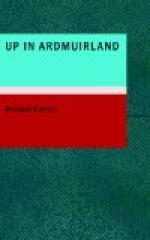“Tell me, in God’s name, who you are and what you want of me?”
The answer came in a clear, distinct voice:
“I am Elizabeth Ashol. I am suffering for a wrong done to my stepson, Gilbert, a monk of your Order. Say Mass for my soul and I shall have rest.”
Then the figure vanished.
Father Vansome naturally had no more sleep that morning. Very early, indeed, he was summoned to his mother’s bedside by her maid, and found her as agitated as himself. From her lips he learned that she too had been visited by the figure he had himself seen. The woman, answering to the description of his ghostly visitor, had approached Mrs. Vansome’s bed, when she was still wide awake, with outstretched hands and entreating eyes, but no voice had been heard.
The apparition to his mother had convinced Father Vansome that what he had experienced was no trick of the imagination. He had, however, taken counsel with Val, who, like himself, was of opinion that the Mass ought to be said. He had found on returning to Ardmuir House that morning that his mother had confided the matter to Mrs. Ashol, and had heard from her that previous visitors had experienced similar apparitions; on further consideration it was discovered—though Mrs. Ashol had not realized it before—that such persons had been invariably Catholics. There was, however, no record of the figure having spoken; this had happened for the first time to the only Benedictine monk who had ever entered the house since Elizabeth Ashol’s death, two centuries before.
It appeared that a certain Dame Elizabeth Ashol, second wife of Gilbert Ashol, lived in the latter part of the seventeenth century. She had one son, Laurence, to whom his father left the estate, to the exclusion of his eldest son, Gilbert, the offspring of the first marriage. This youth, to his father’s intense indignation, had reverted to the faith of his ancestors; soon after his conversion he had entered a monastery on the continent, with a view to returning, as so many of his religious brethren were then doing, to work for the restoration of his fellow-countrymen to the Church. It was generally thought that Dame Elizabeth, in her ambition for the welfare of her own son, had encouraged her husband in his religious bias, and secured the succession for Laurence. It was held in the family that the disasters which had always befallen the first-born of the house dated from the unjust acquisition of the estate by this Laurence, and the entire disinheriting of Gilbert; it was from a kind of superstitious dread attaching to the name that no Ashol for a long term of years had ever been baptized Laurence.
Father Vansome said the required Mass next morning, and his mother drove over to assist at it. Her prayers and mine were thus united with the supreme Sacrifice on behalf of the soul so greatly in need.
The apparition has never been seen again, though many a Catholic guest has visited Ardmuir House. More wonderful still—the curse seems to have been averted by the laying of the ghost; for young Gilbert Ashol has so greatly improved in health and strength that his doctors predict for him a probably long and useful life.




